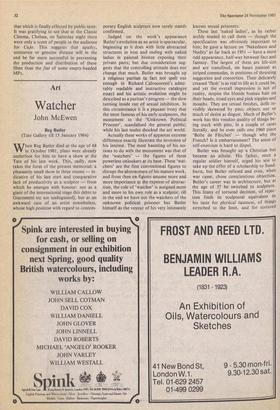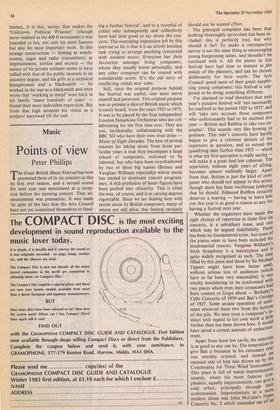Art
Watcher
John McEwen
Reg Butler (Tate Gallery till 15 January 1984)
when Reg Butler died at the age of 68 in October 1981, plans were already underfoot for him to have a show at the Tate of his late work. This, sadly, now takes the form of the present memorial: a pleasantly small show in three rooms — in- dicative of his late start and comparative lack of productivity as a sculptor — from which he emerges with honour: not as a giant of the international stage (his debts to Giacometti etc are undisguised), but as an awkward cuss of an artist nonetheless, whose high position with regard to contem-
porary English sculpture now surely stands confirmed.
Judged on the work's appearance Butler's evolution as an artist is spectacular, beginning as it does with little abstracted structures in iron and ending with naked ladies in painted bronze exposing their private parts; but due consideration sug- gests that the controlling attitude does not change that much. Butler was brought up a religious puritan (a fact not spelt out enough in Richard Calvocoressi's admi• rably readable and instructive catalogue essay) and hiS artistic evolution might be described as a puritan's progress — the slow turning inside out of sexual inhibition. In this circumstance it is a piquant irony that the most famous of his early sculptures, the monument to the 'Unknown Political Prisoner', scandalised the general public; while his last nudes shocked the art world.
Actually these works of apparent extreme difference exactly illustrate the inversion of his interest. The most haunting of his no- tions to do with the monument was that of the 'watchers' — the figures of three powerless onlookers at its base. These 'wat- chers' are the first conventional figures to disrupt the abstractness of his mature work, and from then on figures assume more and more importance at the expense of abstrac- tion, the role of 'watcher' is assigned more and more to his own role as a sculptor, till in the end we have not the watchers of the unknown political prisoner but Butler himself as the voyeur of his very intimately known sexual prisoners.
These last 'naked ladies', as he rather archly tended to call them — though the specification was obviously important to him; he gave a lecture on 'Nakedness and Nudity' as far back as 1951 — have a most odd appearance, half-way between fact and fantasy. The largest of them are life-size and are transfixed, on bases painted as striped commodes, in positions of thrusting suggestion and contortion. Their delicately creased 'flesh' is as real to life as it could be, and yet the overall impression is not of reality, despite the blonde human hair on their heads, irised eyes and pink nipples and mouths. They are sexual fetishes, dolls in- visibly skewered by pins; objects not so much of desire as disgust. Much of Butler's work has this voodoo quality of things be- ing stuck with pins, in a couple of cases literally, and he even calls one 1960 piece 'Boite de Fetiches' — though why the French? Is it embarrassment? The sense of self-exorcism is hard to dispel.
Butler was brought up a Christian but became an atheist. His father, once a regular soldier himself, urged his son to take up the offer of a scholarship to Sand- hurst, but Butler refused and even, when war came, chose conscientious objection. Butler's career was in architecture, but at the age of 37 he switched to sculpture. This litany of tortured decision, of rejec- tion finds its sculptural equivalent in his taste for physical tautness, of things stretched to the limit, and for tortured
themes. It is this, surely, that makes the 'Unknown Political Prisoner' (though never realised as the 400 ft monument it was intended to be), not only his most famous but also his most important work. In this strange construction — hinting at watch- towers, cages and radio transmitters; at imprisonment, torture and secrecy — the nature of his private torment seems to have tallied with that of the public moment to an uncanny degree, and his gifts as a technical draughtsman and a blacksmith — he worked in the war as a blacksmith and once wrote that 'working in metal' went back in his family 'many hundreds of years' found their most indivisible expression. But from that high moment his vision as a sculptor narrowed till the end.















































 Previous page
Previous page